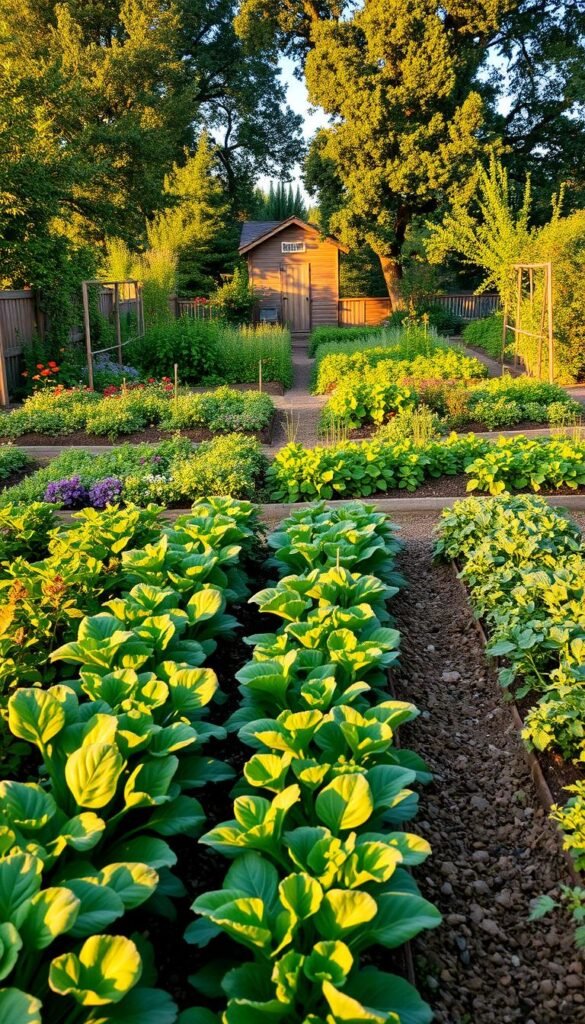Imagine stepping into your backyard and picking fresh produce every month, even when frost nips the air. A well-planned rotation system turns this vision into reality by working with nature’s rhythms instead of against them. Changing what you grow in each area of your garden isn’t just about variety—it’s a science that revitalizes your soil, deters pests, and keeps your harvests thriving.
Think of your garden as a living puzzle. Each crop plays a role in balancing nutrients and preventing disease buildup. For example, pairing nitrogen-loving plants with soil-enriching legumes creates a natural fertilizer effect. This approach slashes your reliance on store-bought amendments while boosting yields.
Whether you’re growing herbs in containers or managing raised beds, smart planning ensures every inch works efficiently. Rotating crops like leafy greens with root vegetables maintains soil structure and moisture retention—critical for regions with harsh winters. Discover how to extend your growing season with winter-ready vegetables that thrive in cooler temperatures.
By aligning your planting schedule with these strategies, you’ll create a self-sustaining ecosystem. The result? A garden that flourishes year-after-year, delivering abundance without exhausting your resources—or your energy.
Overview of Seasonal Crop Rotations
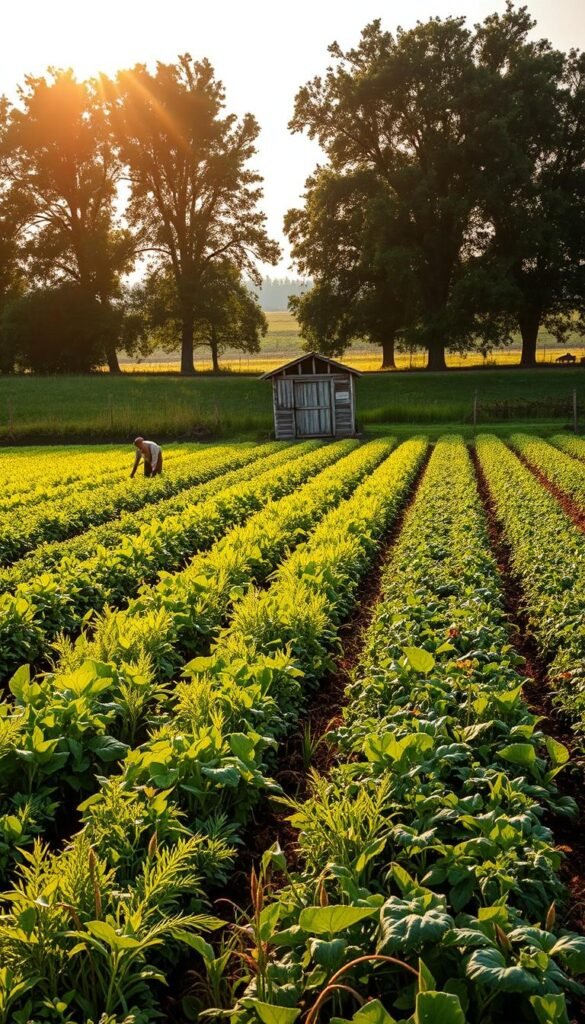
Your garden isn’t just a plot of dirt—it’s a living laboratory where smart planting creates lasting rewards. Crop rotation works like nature’s reset button, breaking pest cycles and replenishing nutrients without chemicals. By switching plant families in specific areas each season, you build a self-repairing system that grows stronger over time.
Deep-rooted vegetables like daikon radish naturally aerate compacted soil, while legumes team up with bacteria to add nitrogen back into the earth. This isn’t random plant shuffling—it’s a science-based strategy. Each crop prepares the ground for the next, creating a chain of improvement that prevents depletion.
Timing matters as much as plant selection. Aligning rotations with your local frost dates and seasonal care strategies maximizes growth windows. You’ll spend less time battling bugs or hungry soil because each plant family disrupts pest lifecycles and balances nutrient demands.
Mastering these principles now means fewer headaches later. Your garden becomes a low-maintenance powerhouse, producing food through smart design rather than constant effort. Start simple—track where tomatoes, beans, or leafy greens grew last year—and watch how this ancient practice transforms your harvests.
Benefits of Crop Rotation for Your Organic Garden
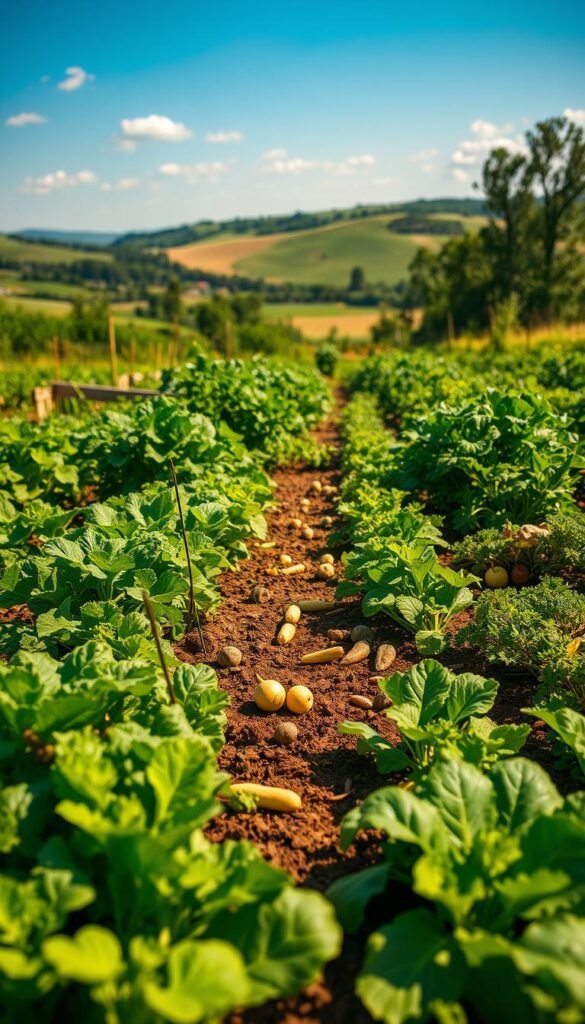
Your garden’s secret weapon against problems isn’t a spray bottle—it’s smart plant shuffling. Rotating where you grow vegetables creates natural defenses against invaders while keeping your dirt bursting with life. Let’s explore how this simple practice becomes your best ally.
Outsmarting Unwanted Visitors
Pests are creatures of habit. When you grow the same plants in the same spot yearly, bugs like tomato hornworms set up permanent homes. Shift their favorite snacks to new locations, and watch pest numbers plummet. Studies show this strategy cuts infestations by 80%—no chemicals needed.
Diseases struggle with relocation too. Soil-borne illnesses like early blight can’t survive when their host plants disappear for 3-4 years. Planting garlic after tomatoes cleanses the ground naturally. Some crops even fight pathogens—brassicas release compounds that suppress harmful nematodes.
Feeding the Earth That Feeds You
Different plants have unique appetites. Leafy greens guzzle nitrogen, while root vegetables mine phosphorus. Rotating heavy feeders with soil-building legumes creates perfect balance. Beans and peas team up with bacteria to fix nitrogen, leaving 30% more for future crops.
This nutrient dance prevents exhaustion. After harvesting nitrogen-hungry corn, plant nitrogen-producing clover. You’ll slash fertilizer costs while boosting soil health through natural processes. Over time, organic matter increases, creating fluffy, moisture-rich earth.
| Plant Family | Soil Impact | Pest Control Benefit |
|---|---|---|
| Nightshades | High phosphorus use | Break fungal disease cycles |
| Legumes | Adds nitrogen | Disrupts root-eating beetles |
| Brassicas | Mines minerals | Suppresses nematodes |
| Leafy Greens | Needs rich nitrogen | Avoids leafhopper buildup |
Assessing Your Climate and Garden Zones
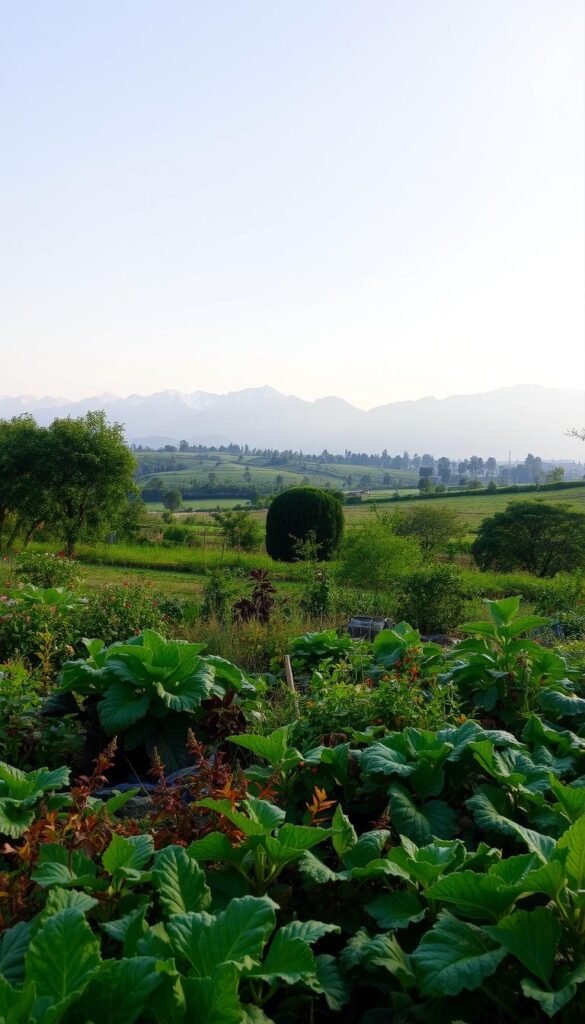
Every thriving garden is a love letter to its specific climate conditions and seasonal rhythms. Your local weather patterns act like invisible partners in growth—learn their language, and you’ll unlock smarter planting choices that work with nature’s flow.
Identifying Your USDA Hardiness Zone
Start by finding your gardening GPS coordinates. The USDA Hardiness Zone map divides North America into 13 zones based on average winter lows. A quick search using your ZIP code on the USDA website reveals your zone number—crucial for selecting plants that survive your coldest months.
But zones aren’t everything. Urban heat islands can make downtown areas warmer than rural spots in the same zone. Connect with your county extension office for hyper-local insights. They’ll help you choose crops suited to your exact conditions, whether you’re in Minnesota’s chilly Zone 3 or Florida’s balmy Zone 10.
Tracking Frost Dates and Growing Seasons
Your growing season length hinges on frost dates. Record your area’s average last spring frost and first fall frost—these dates bookend your prime planting window. Tools like the National Gardening Association’s calculator simplify this process, but keep a weather journal too.
Note microclimate quirks: south-facing slopes thaw earlier, while low areas collect frost. Northern gardeners might use cold frames to stretch their season, while southerners focus on heat-tolerant varieties. One Arizona gardener increased her tomato yields by 40% simply by shifting planting dates two weeks earlier to beat summer scorchers.
This climate awareness lets you match crops to your unique conditions. You’ll swap guesswork for confidence when selecting seeds and timing rotations—your plants will thank you with robust growth.
Grouping Crops by Botanical Families and Nutrient Needs
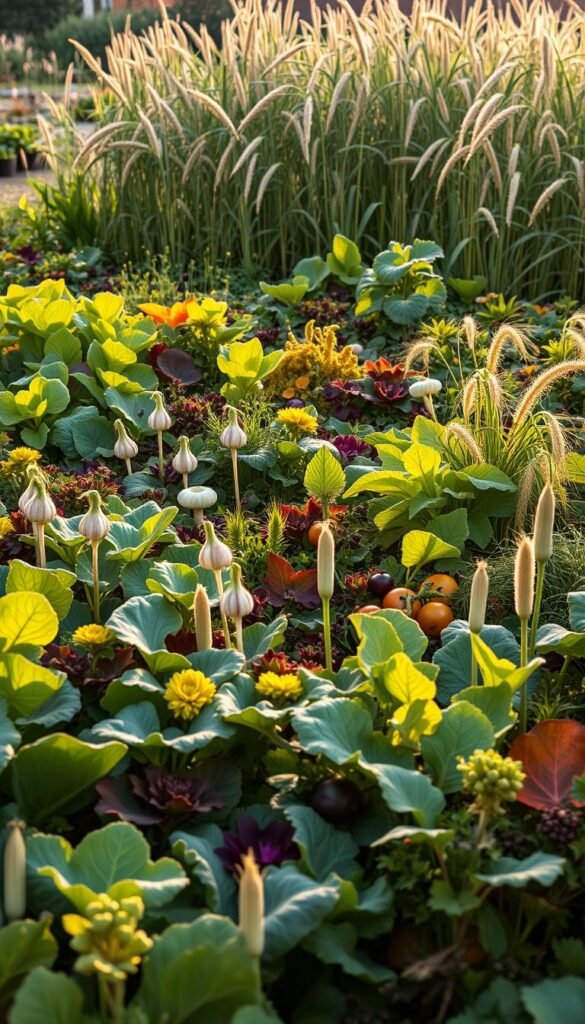
Organizing your plants like family reunions keeps your soil thriving. Each botanical group shares unique traits—from root depth to pest vulnerabilities—that determine where they grow best. Understanding these connections helps you build nutrient cycles that work like nature’s recycling program.
Meet the Four Key Plant Clans
Nightshades (tomatoes, peppers) demand extra nitrogen but leave phosphorus behind. Legumes (beans, peas) partner with soil bacteria to convert air nitrogen into plant food. Brassicas (broccoli, kale) drill deep roots to mine minerals, while cucurbits (squash, cucumbers) spread shallow roots that wilt easily in dry spells.
Balancing Your Garden’s Diet
Plants eat differently. Heavy feeders like corn drain nutrients fast. Light feeders like carrots use leftovers efficiently. Soil builders like clover actually feed your garden. Rotate these groups to prevent nutrient theft:
| Category | Examples | Soil Impact |
|---|---|---|
| Heavy Feeders | Tomatoes, Corn | Require added nutrients |
| Light Feeders | Carrots, Herbs | Use existing resources |
| Soil Builders | Beans, Clover | Enrich fertility |
Pair deep-rooted brassicas with shallow cucurbits next season. The brassicas’ taproots break up compacted earth, letting moisture reach squash roots. For small-space rotations, alternate containers between nutrient-demanding and soil-repairing plants. Your dirt stays lively without chemical boosts.
Developing a Four-Year Rotation Plan
Building a garden that thrives for years starts with a smart planting timeline. A four-year rotation cycle acts like nature’s clock, giving your soil time to recharge while keeping pests guessing. This method turns your plots into a productivity engine that grows stronger with each passing year.
Year One: Leafy Crops
Kick off your cycle where legumes previously grew. Nitrogen-rich earth from beans or peas fuels leafy greens like spinach and kale. These quick-growing plants use nutrients efficiently, setting the stage for heavier feeders next season.
Year Two: Fruiting and Year Three: Root Crops
Tomatoes and peppers thrive in year two’s balanced soil. Their deep roots access nutrients left by leafy greens. By year three, switch to carrots and beets—these root vegetables excel in lower-nitrogen conditions while breaking up compacted earth.
Year Four: Legumes and Cover Crops
Complete the cycle with soil superheroes. Clover or vetch plants partner with bacteria to fix nitrogen, while rye grass adds organic matter. This green blanket protects earth between plantings and preps beds for year one’s leafy stars.
Over four years, this system creates a 22% boost in yields according to agricultural studies. Diseases fade as pests lose their favorite hangouts. When it’s time to enjoy your bounty, proper harvesting techniques ensure every bite tastes like victory.
Mapping Your Garden Beds and Creating Planting Records
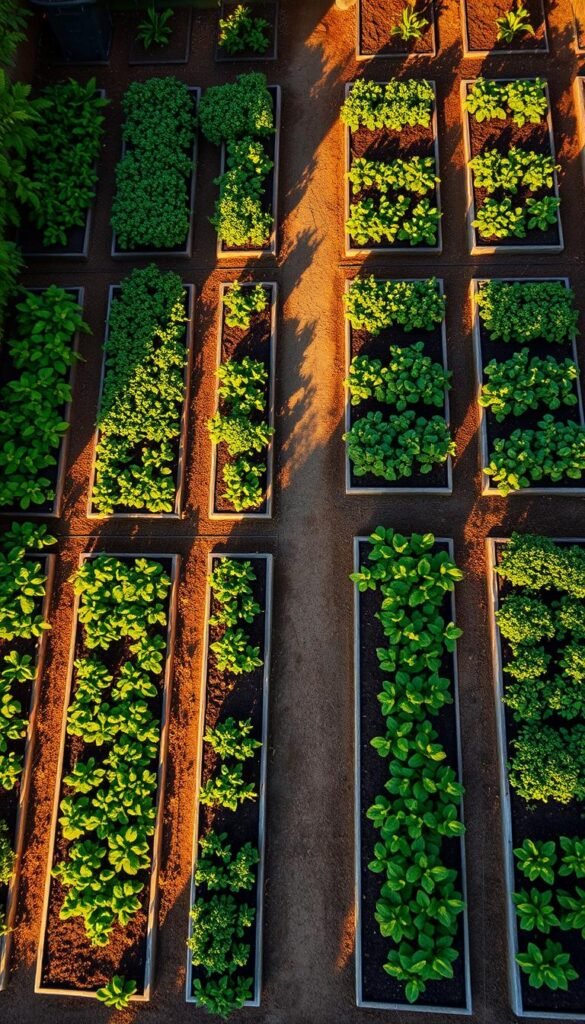
Your garden’s success story begins with pencil and paper. Documenting your growing spaces transforms guesswork into precision, helping you spot patterns and opportunities. Whether sketching on grid sheets or tapping a tablet screen, these records become your green thumb’s playbook.
Sketching Your Green Blueprint
Grab graph paper and measure every bed’s exact size. Mark permanent features—trees, compost bins, or raised beds—that cast shade or affect drainage. Use colored pencils to highlight zones: blue for soggy areas, yellow for full sun spots. This visual cheat sheet ensures tomatoes get their six-hour sun minimum while lettuce stays cool.
Digital Tools for Smarter Growing
Apps like GrowVeg turn rotation planning into a drag-and-drop game. Input your bed dimensions once, and the software tracks what grew where. Get alerts like “Tomatoes shouldn’t return here until 2027” based on disease cycles. Pair this with a simple notebook logging planting dates and yields—you’ll soon spot which areas outperform others.
Combining analog and digital methods works wonders. One gardener using the square foot method doubled her harvests by cross-referencing app data with hand-drawn sun maps. Your records become a time capsule, showing how that shady corner became prime real estate for kale after strategic tree pruning.
Using Cover Crops and Green Manures for Soil Vitality
Your soil deserves a vacation too—cover crops give it the rest and recharge it needs. These unsung heroes work double duty, protecting your beds while boosting fertility. Think of them as nature’s multitaskers, working underground and above to improve soil health even when your main plants take a break.
Cold-Weather Champions
When frost arrives, cereal rye steps up. Its deep roots lock soil in place, stopping erosion while adding organic matter. Pair it with crimson clover—this fuzzy ally teams up with bacteria to stash nitrogen underground. Together, they create a living blanket that keeps earth active through winter’s chill.
Summer’s Speedy Helpers
Buckwheat grows faster than weeds in warm months. Plant it between tomato harvests to smother unwanted plants and attract pollinators. For sizzling climates, cowpeas thrive in heat while pumping nitrogen into the ground. Their vigorous growth builds soil structure, making beds fluffier for future crops.
Whether you’re battling mudslides in March or dust bowls in July, cover crops adapt to your needs. They’re the quiet partners that keep your garden’s foundation strong, season after season.

